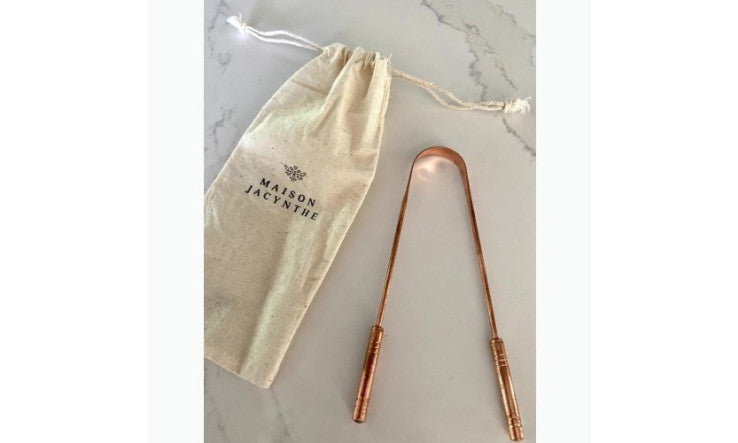Why tongue scraping?
When we sleep, bacteria settle on our tongues and form a thin, whitish layer that causes bad breath. Scraping the tongue is a quick way to remove these particles, and this is done with an instrument called a tongue scraper.
Although this scraping cannot replace a good tooth brushing, its benefits have prompted many to add this extra step to their daily oral routine.
How is tongue scraping beneficial?
Debris can build up on your tongue over time and this can lead to bad breath and negatively impact overall oral health.
Using a tongue scraper can help remove this buildup, and in other aspects, it can also improve the sense of taste, the appearance of the tongue and reduce bad breath (1) , eliminating bacteria, among others, those causing bad breath and tooth decay (2) .
How often should you scrape your tongue?
While it's true that scraping in the morning can help combat bad breath, it can develop later in the day as bacteria builds up as you eat and drink.
The minimum that can be done is to do it every time you brush your teeth, to avoid buildup. This takes about 2 minutes.
How to do tongue scraping?
Here is the process and points to consider that can be found on the Healtline.com website (3) :
- Stand in front of a mirror, open your mouth and stick out your tongue.
- Gently place the rounded end of the tongue scraper on the back of your tongue.
- If you're worried about nausea, it may be helpful to start from the middle of your tongue. You can gradually work your way out as you get used to scraping.
- Gently place the scraper on your tongue. Slowly pull it forward, toward the tip of your tongue. You should never push the tongue scraper back from the tip of your tongue. Always move from the back of your tongue to the tip.
- After each scraping, use a washcloth or tissue to remove debris from the scraper.
- Repeat until you have scraped the entire surface of your tongue. Once or twice on the same area is usually sufficient.
- Wash the tongue scraper with warm water and soap, dry it and store it in a clean, dry place.
Be aware of the pressure to apply to avoid accidentally damaging the surface of the tongue with the tongue scraper. If in doubt, start gently at first and gradually increase it.
Other ways to improve oral hygiene
- Tongue scraping can be beneficial and a complement to oral hygiene.

- Brush your teeth at least twice a day, for at least 2 minutes, with toothpaste and use mouthwash to help fight cavities.
- Floss to remove hard-to-reach debris between teeth.

- Drink plenty of water to avoid dry mouth, which is often a cause of bad breath.

- Don't forget to make regular visits to the dentist for cleanings and checkups to maintain your oral health and as a preventative measure.

Inspiration & sources:
(1) https://onlinelibrary.wiley.com/doi/abs/10.1111/j.0303-6979.2004.00507.x Impact of tongue cleansers on microbial load and taste Journal of clinical Peridontology M. Quirynen, P. Avontroodt, C. Soers, H. Zhao, M. Pauwels, D. Van Steenberghe First published: 17 May 2004
(2) https://pubmed.ncbi.nlm.nih.gov/16032940/ The effect of tongue scraper on mutans streptococci and lactobacilli in patients with caries and periodontal disease Khalid Almas, Essam Al-Sanawi, Bander Al-Shahrani Odontostomatol Trop 2005 Mar;28(109):5-10.
(3) https://www.healthline.com/health/dental-and-oral-health/tongue-scraping#other-oral-health-tips
To learn a little more about another Ayurvedic practice, oil-pulling, click here!


































































